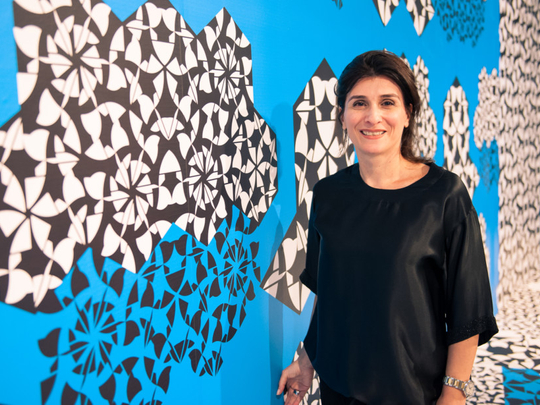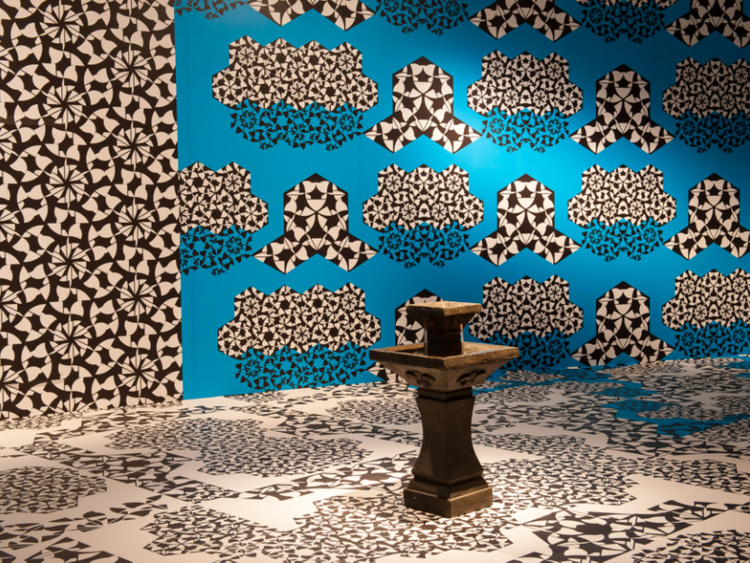
Sharjah’s new design space, 1971, is hosting a garden of paradise-themed exhibition titled “Garden After” by Lebanese multi-disciplinary artist, designer and consultant, Jamal Tayara-Baroudy.
The exhibition, which opened in late June, is based on the spiritual symbolism associated with the Abrahamic religions’ concept of paradise.
“Garden After” is an immersive installation composed of a fountain, wallpaper and floor patterns, which change in scale and perspective depending on how close up one views it. The installation’s key elements are flowing water, shade and diverse foliage, which represent both the physical and spiritual realms.
The installation radiates out from a central point, the river, pivotal in Quranic descriptions of the garden of paradise, in fluid linear patterns. The work has both distorted scale and perspective based on the artist’s imaginative interpretation of nature as her own paradise. She imagines species of flora inspired by Islamic geometric thinking and combines it with remembered elements from her childhood.
For her new installation, Tayara-Baroudy has taken inspiration from descriptions of the Garden of Paradise in the Quran, as well as Islamic garden architecture and her childhood memories. Numerous verses in the Quran celebrate water and plants, particularly in the Garden and in “Jannah” (heaven). In “Jannah”, there are shade-giving fruit trees, green pastures and fountains — particularly appealing to desert-dwelling people.
“Childhood memories in the pine tree forests are an essential aspect for the inspiration behind my ‘Garden After’ installation, yet, there are many other important inspirational aspects for the show, most importantly Islamic art craftsmanship,” Tayara-Baroudy tells Weekend Review.
Tayara-Baroudy’s preparatory work looks at how plants undergo transformation and links this to the metamorphosis of the human body into a spirit. Her work continues past traditions of using specific flora for the purpose of ornamentation, but uses digital tools to create additional layers of subjective impressions and interpretations.
“Gardens are manmade. We humans interfere with nature to beautify it and rearrange it but maybe in reality it does not need us. I think we always want to be in control of nature, something I will do in my show. I won’t be documenting what already exists, I will be gardening. I will be combining species and plants that in reality may not survive together,” says Tayara-Baroudy.
“‘Garden After’ is a design show and it has taken a traditional craftsmanship into a contemporary expression, with the newly created order that is not seen in the past. It is contemporary with the vinyl sticker medium allowing us to cut and paste freely; contemporary as a story can be expressed with pattern, so that the pattern skips being simply ornamental.”
About the process of abstraction that resulted in the conceptualisation of “Garden After”, the artist says: “The installation continues my exploration with pattern. It is my little heaven in black and white and blue after it has been dissected and constructed by mathematics.”
Explaining the layout of the display, she says: “It is a visual expression in two parts: wall and floor.”
“Firstly the wall pattern, in its very minimal grid system expresses what it meant for a child raised during the war, to be outdoors in nature surrounded by trees and plant species and most of all, the sky as the ceiling. It felt like being in heaven!
“Secondly, the floor carpet carried my interpretation of what could be ‘lush’ nature in heaven. The intricate patterns constructed within a mathematical grid build up from metamorphosed shapes creating an endless number of flora species. Metamorphosis of the body into a spirit is also expressed in the metamorphosis of the shapes in the abstract garden I created. The abstract expression and the lack of colour in my installation are very important as to invite the audience to imagine their own ‘Garden After’.
“The link between wall and floor is the reflection of the sky in the water, the blue colour. The four rivers mentioned in the Quran are visible in the composition. The scale is important as well, as for a child nature seems bigger, especially when most of your days are spent playing indoors.”
Regarding the connecting factor between “Garden After” and her previous work and shows, Tayara-Baroudy says: “As an artist/designer my work grows out of discipline in graphic design. My interest is with lines, shapes, grid and structures in its most monochrome vector format. As I said earlier, the installation continues my exploration with pattern and forms in Islamic art.”
At present, Tayara-Baroudy is working on different projects, taking her pattern designs “into a new challenge”.
“Wanting to create the rationale that could be inspired from the spiritual or the non-specific; wanting to create what feels right — even if you can’t find words for it, you will find an art/design language for it,” she says about the inspiration throughout her artistic career and work.
The show comes after several successful exhibitions at the Maraya Art Centre, Sharjah, the artist has participated in. These include “The Beginning of Thinking is Geometric” (2013) and “Islamopolitan” (2014), with the latter having been exhibited in Turkey during Istanbul Design Art Week and in Italy during Expo 2015 Milan.
Tayara-Baroudy is also exhibiting prayer carpet designs, inspired by the fact that these rugs are considered doors to heaven and often feature depictions of garden scenes.
According to the show’s curator Dr Alexandra MacGilp, “The audience has enjoyed being in the peaceful yet stimulating space Jamal has created in the gallery. The installation takes on a different character as the light fades outside and undulating shadows form under the electric lights.
“At the exhibition opening, which was during Ramadan, the visitors had fun taking photographs of each other in the installation and talking to the artist about the manifold influences behind her work. As in a real garden, ‘Garden After’ provided the perfect setting for an iftar hosted by 1971 design space where guests sat around a table on the floor chatting and soaking up the atmosphere. Besides its powerful visual aspects, the installation includes the sounds of birds and a water fountain.”
New design space
1971, the UAE’s newest experimental design hotspot, can be found on Sharjah’s iconic Flag Island. Far more than a gallery, the innovative art space aspires to become a regional and international design hub in the UAE that works closely with designers, architects, schools and universities from the region to present a contemporary and cutting-edge mix of curated exhibitions and public programmes.
1971 is a multi-functional design space dedicated to exhibition, display and discussion on all forms of contemporary design ranging from graphics, furniture and interiors to interactive design and new design technologies. It also services as an informal meeting venue and includes a fully serviced café.
Curator Dr Alexandra MacGilp says, “1971 opened this year with the exhibition ‘Zero’, which was an open call to designers to submit designs using recycled materials provided by Bee’ah waste management in Sharjah. The selected projects included seating units and installations often inspired by the local environment and indigenous architecture.
“Alongside this, 1971 had a stand at Design Days Dubai in March showcasing the work of Amer Al Dour who created an interactive, kinetic installation called ‘Analogue Arabesque’. 1971 also hosted a successful Pecha Kucha night with environmental issues as the theme recently.
“After Jamal Tayara-Baroudy’s show is 1971’s first fashion exhibition ‘De.Fash.Struction’, curated by Khulood Thani which opens in October. 1971 will continue to originate and host design exhibitions, workshops and talks as well as collaborating with organisations locally and abroad.”
A cross-discipline creative professional
Jamal Tayara-Baroudy is a multi-disciplinary creative professional and consultant. At present, both art and design overlap in her work, which employs motif and repetition to create distinctive patterns.
She has worked throughout the Middle East for individual clients and international branding agencies on innovative projects in art and design from concept to completion.
She was the creative director behind Al,āan Artspace project in Riyadh, where she was an integral part of the directorial team responsible for all facets of design and branding.
Tayara-Baroudy maintains an independent branding studio — jamjardesign — established in 2002, and Art Like This*, established in 2011, an independent graphic art studio focusing on art and design projects and site-specific installations.
She is a graduate of the Lebanese American University (formerly BUC) with a double major in Fine Arts and Graphic Design. Additionally, she has undertaken further studies at Sotheby’s Institute of Art, London.
- N.P. Krishna Kumar is a freelance writer based in Dubai.
“Garden After” runs until September 26 at 1971: Design Space, The Flag Island, Sharjah. For more information, log on to www.maraya.ae












